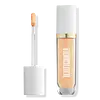What's inside
What's inside
 Key Ingredients
Key Ingredients

 Benefits
Benefits

 Concerns
Concerns

 Ingredients Side-by-side
Ingredients Side-by-side

Water
Skin ConditioningDimethicone
EmollientCaprylic/Capric Triglyceride
MaskingTrimethylsiloxysilicate
EmollientEthylhexyl Palmitate
EmollientDiisostearoyl Polyglyceryl-3 Dimer Dilinoleate
EmollientCoco-Caprylate
EmollientGlycerin
HumectantOleyl Oleate
EmollientLauroyl Lysine
Skin ConditioningGluconolactone
Skin ConditioningMagnesium Sulfate
Cera Alba
EmollientPersea Gratissima Oil
Skin ConditioningPolygonum Aviculare Extract
EmollientHydrogenated Vegetable Oil
EmollientSodium Chloride
MaskingHydrogenated Castor Oil
EmollientSodium Benzoate
MaskingDimethicone/Vinyl Dimethicone Crosspolymer
Skin ConditioningTocopheryl Acetate
AntioxidantLecithin
EmollientTocopherol
AntioxidantCalcium Gluconate
HumectantPotassium Sorbate
PreservativeCI 77891
Cosmetic ColorantIron Oxides
Water, Dimethicone, Caprylic/Capric Triglyceride, Trimethylsiloxysilicate, Ethylhexyl Palmitate, Diisostearoyl Polyglyceryl-3 Dimer Dilinoleate, Coco-Caprylate, Glycerin, Oleyl Oleate, Lauroyl Lysine, Gluconolactone, Magnesium Sulfate, Cera Alba, Persea Gratissima Oil, Polygonum Aviculare Extract, Hydrogenated Vegetable Oil, Sodium Chloride, Hydrogenated Castor Oil, Sodium Benzoate, Dimethicone/Vinyl Dimethicone Crosspolymer, Tocopheryl Acetate, Lecithin, Tocopherol, Calcium Gluconate, Potassium Sorbate, CI 77891, Iron Oxides
Water
Skin ConditioningDimethicone
EmollientIsododecane
EmollientGlycerin
HumectantCetyl PEG/PPG-10/1 Dimethicone
EmulsifyingDimethicone/Vinyl Dimethicone Crosspolymer
Skin ConditioningMethyl Methacrylate Crosspolymer
Isopentyldiol
HumectantCaprylyl Methicone
Skin ConditioningSorbitan Sesquioleate
EmulsifyingSilica
AbrasiveButylene Glycol Dicaprylate/Dicaprate
EmollientPropanediol
SolventQuaternium-90 Bentonite
Cetyl Ethylhexanoate
EmollientHydrogenated Styrene/Methylstyrene/Indene Copolymer
Triethoxycaprylylsilane
Propylene Carbonate
SolventPhenoxyethanol
PreservativeAmmonium Acryloyldimethyltaurate/Vp Copolymer
Sodium Dehydroacetate
PreservativeHydrogenated Styrene/Isoprene Copolymer
Caprylyl Glycol
EmollientCaprylhydroxamic Acid
Sodium Hyaluronate
HumectantTocopherol
AntioxidantHelianthus Annuus Seed Oil
EmollientHexylene Glycol
EmulsifyingEthylhexylglycerin
Skin ConditioningPropylene Glycol
HumectantPassiflora Edulis Seed Oil
EmollientSchinziophyton Rautanenii Kernel Oil
EmollientMacadamia Integrifolia Seed Oil
Skin ConditioningArgania Spinosa Kernel Oil
EmollientGlycine Soja Oil
EmollientCocos Nucifera Oil
MaskingPentaerythrityl Tetra-Di-T-Butyl Hydroxyhydrocinnamate
AntioxidantChamomilla Recutita Flower Extract
MaskingSorbitol
HumectantIron Oxides
CI 77492
Cosmetic ColorantCI 77499
Cosmetic ColorantWater, Dimethicone, Isododecane, Glycerin, Cetyl PEG/PPG-10/1 Dimethicone, Dimethicone/Vinyl Dimethicone Crosspolymer, Methyl Methacrylate Crosspolymer, Isopentyldiol, Caprylyl Methicone, Sorbitan Sesquioleate, Silica, Butylene Glycol Dicaprylate/Dicaprate, Propanediol, Quaternium-90 Bentonite, Cetyl Ethylhexanoate, Hydrogenated Styrene/Methylstyrene/Indene Copolymer, Triethoxycaprylylsilane, Propylene Carbonate, Phenoxyethanol, Ammonium Acryloyldimethyltaurate/Vp Copolymer, Sodium Dehydroacetate, Hydrogenated Styrene/Isoprene Copolymer, Caprylyl Glycol, Caprylhydroxamic Acid, Sodium Hyaluronate, Tocopherol, Helianthus Annuus Seed Oil, Hexylene Glycol, Ethylhexylglycerin, Propylene Glycol, Passiflora Edulis Seed Oil, Schinziophyton Rautanenii Kernel Oil, Macadamia Integrifolia Seed Oil, Argania Spinosa Kernel Oil, Glycine Soja Oil, Cocos Nucifera Oil, Pentaerythrityl Tetra-Di-T-Butyl Hydroxyhydrocinnamate, Chamomilla Recutita Flower Extract, Sorbitol, Iron Oxides, CI 77492, CI 77499
Ingredients Explained
These ingredients are found in both products.
Ingredients higher up in an ingredient list are typically present in a larger amount.
Dimethicone is a type of synthetic silicone created from natural materials such as quartz.
What it does:
Dimethicone comes in different viscosities:
Depending on the viscosity, dimethicone has different properties.
Ingredients lists don't always show which type is used, so we recommend reaching out to the brand if you have questions about the viscosity.
This ingredient is unlikely to cause irritation because it does not get absorbed into skin. However, people with silicone allergies should be careful about using this ingredient.
Note: Dimethicone may contribute to pilling. This is because it is not oil or water soluble, so pilling may occur when layered with products. When mixed with heavy oils in a formula, the outcome is also quite greasy.
Learn more about DimethiconeThis ingredient is a silicone used to improve the texture of products and absorb oil. It does not get absorbed into the skin.
Like other silicones, Dimethicone/Vinyl Dimethicone Crosspolymer helps condition the skin by creating a barrier. In this sense, it can act as an emollient and trap moisture in.
This ingredient is a type of elastomer.
Learn more about Dimethicone/Vinyl Dimethicone CrosspolymerGlycerin is already naturally found in your skin. It helps moisturize and protect your skin.
A study from 2016 found glycerin to be more effective as a humectant than AHAs and hyaluronic acid.
As a humectant, it helps the skin stay hydrated by pulling moisture to your skin. The low molecular weight of glycerin allows it to pull moisture into the deeper layers of your skin.
Hydrated skin improves your skin barrier; Your skin barrier helps protect against irritants and bacteria.
Glycerin has also been found to have antimicrobial and antiviral properties. Due to these properties, glycerin is often used in wound and burn treatments.
In cosmetics, glycerin is usually derived from plants such as soybean or palm. However, it can also be sourced from animals, such as tallow or animal fat.
This ingredient is organic, colorless, odorless, and non-toxic.
Glycerin is the name for this ingredient in American English. British English uses Glycerol/Glycerine.
Learn more about GlycerinTocopherol (also known as Vitamin E) is a common antioxidant used to help protect the skin from free-radicals and strengthen the skin barrier. It's also fat soluble - this means our skin is great at absorbing it.
Vitamin E also helps keep your natural skin lipids healthy. Your lipid skin barrier naturally consists of lipids, ceramides, and fatty acids. Vitamin E offers extra protection for your skin’s lipid barrier, keeping your skin healthy and nourished.
Another benefit is a bit of UV protection. Vitamin E helps reduce the damage caused by UVB rays. (It should not replace your sunscreen). Combining it with Vitamin C can decrease sunburned cells and hyperpigmentation after UV exposure.
You might have noticed Vitamin E + C often paired together. This is because it is great at stabilizing Vitamin C. Using the two together helps increase the effectiveness of both ingredients.
There are often claims that Vitamin E can reduce/prevent scarring, but these claims haven't been confirmed by scientific research.
Learn more about TocopherolWater. It's the most common cosmetic ingredient of all. You'll usually see it at the top of ingredient lists, meaning that it makes up the largest part of the product.
So why is it so popular? Water most often acts as a solvent - this means that it helps dissolve other ingredients into the formulation.
You'll also recognize water as that liquid we all need to stay alive. If you see this, drink a glass of water. Stay hydrated!
Learn more about WaterThis ingredient is a combination of red, black, and yellow iron oxide pigments. This combination of colors is usually found in foundation, because it results in a "skin" color.